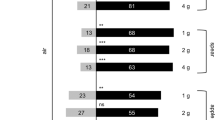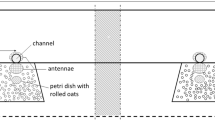Abstract
This study investigated the influence of the plant antifeedants, pinosylvin and pinosylvin methyl ether (PME), on suppression of feeding by snowshoe hares (Lepus americanus). Screening bioassays showed clearly that pinosylvin suppressed feeding by hares when sprayed directly on coniferous tree seedlings. Pinosylvin odor, when associated with food (but not mixed with it), also significantly reduced consumption of rabbit chow by hares. Large pen bioassays indicated that both pinosylvin and PME significantly reduced feeding on tree seedlings by hares when the antifeedants were sprayed directly on trees. In field bioassays near Prince George, British Columbia, Canada, pinosylvin sprayed on trees and encapsulated in controlled-release devices of PVC plastic, with an internal wire as a twist-tie for attachment to tree, significantly reduced feeding by hares. Thus, pinosylvin will generate an “avoidance response” in terms of feeding by snowshoe hares. This response is likely triggered by an olfactory pathway based on positive results with controlledrelease devices attached to seedlings. Our study reports the first practical utilization of plant antifeedants for forest crop protection and wildlife management.
Similar content being viewed by others
References
Bell, C.M., andHarestad, A.S. 1987. Efficacy of pine oil as repellent to wildlife.J. Chem. Ecol. 13:1409–1417.
Bergeron, J.M., andTardif, J. 1988. Winter browsing preferences of snowshoe hares for coniferous seedlings and its implication in large-scale reforestation programs.Can. J. For. Res. 18:280–282.
Bryant, J.P. 1981. Phytochemical deterrence of snowshoe hare browsing by adventitious shoots of four Alaskan trees.Science 313:889–890.
Bryant, J.P., andKuropat, P.J. 1980. Selection of winter forage by subarctic browsing vertebrates: The role of plant chemistry.Annu. Rev. Ecol. Syst. 11:261–285.
Bryant, J.P., Wieland, G.D., Reichardt, P.B., Lewis, V.E., andMcCarthy, M.C. 1983. Pinosylvin methyl ether deters snowshoe hare feeding on green alder.Science 222:1023–1025.
Clausen, T.P., Reichardt, P.B., andBryant, J.P. 1986. Pinosylvin and pinosylvin methyl ether as feeding deterrents in green alder.J. Chem. Ecol. 12:2117–2131.
Coley, P.D., Bryant, J.P., andChapin, F.S. 1985. Resource availability and plant antiherbivore defense.Science 230:895–899.
Conroy, M.J., Gysel, L.W., andDudderar, G.R. 1979. Habitat components of clear-cut areas for snowshoe hares in Michigan.J. Wildl. Manage. 43:680–690.
Elliot, S., andLoudon, A. 1987. Effects of monoterpene odors on food selection by red deer calves (Cervus elephus).J. Chem. Ecol. 13:1343–1349.
Fox, J.F. 1978. Forest fires and snowshoe hare—Canada lynx cycle.Oecologia (Berlin)31:349–374.
Green, J.E. 1978. Techniques for the control of small mammal damage to plants: A review. Alberta Oil Sands Environmental Research Program. Project VE 7.1.1.
Hansson, L., Gref, R., Lundgren, L., andTheander, O. 1986. Susceptibility to vole attacks due to bark phenols and terpenes inPinus contorta provenances introduced into Sweden.J. Chem. Ecol. 12:1569–1578.
Jogia, M.K., Sinclair, A.R.E., andAndersen, R.J. 1989. An antifeedant in balsam poplar inhibits browsing by snowshoe hares.Oecologia (Berlin)79:189–192.
Keith, L.B. 1963. Wildlife's Ten-Year Cycle. University of Wisconsin Press, Madison.
Keith, L.B., andWindberg, L.A. 1978. A demographic analysis of the snowshoe hare cycle.Wildl. Monogr. No. 58.
Pease, J.L., Vowles, R.H., andKeith, L.B. 1979. Interaction of snowshoe hares and woody vegetation.J. Wildl. Manage. 43:43–60.
Pietz, P.J., andTester, J.R. 1983. Habitat selection by snowshoe hares in north central Minnesota.J. Wildl. Manage. 47:686–696.
Radvanyi, A. 1987. Snowshoe hares and forest plantations: A literature review and problem analysis. Inf. Rep. NOR-X-290. Can. For. Serv., North. For. Cent., Edmonton, Alberta.
Reichardt, P.B., Bryant, J.P., Clausen, T.P., andWieland, G. 1984. Defense of winterdormant Alaskan paper birch against snowshoe hare.Oecologia (Berlin)65:58–69.
Reichardt, P.B., Bryant, J.P., Anderson, B.J., Phillips, D., Clausen, T.P., Meyer, M., andFrisby, K. 1990a. Germacrone defends labrador tea from browsing by snowshoe hares.J. Chem. Ecol. 16:1961–1970.
Reichardt, P.B., Bryant, J.P., Mattes, B.R., Clausen, T.P., Chapin, F.S., andMeyer, M. 1990b. Winter chemical defense of Alaskan balsam poplar against snowshoe hares.J. Chem. Ecol. 16:1941–1959.
Roy, J., andBergeron, J.M. 1990a. Role of phenolics of coniferous trees as deterrents against debarking behavior of meadow voles (Microtus pennsylvanicus).J. Chem. Ecol. 16:801–808.
Roy, J., andBergeron, J.-M. 1990b. Branch-cutting behavior by the vole (Microtus pennsylvanicus). A mechanism to decrease toxicity of secondary metabolites in conifers.J. Chem. Ecol. 16:735–741.
Sinclair, A.R.E., Jogia, M.K., andAnderson, R.J. 1988. Camphor from juvenile white spruce as an antifeedant for snowshoe hares.J. Chem. Ecol. 14:1505–1514.
Strong, W.L., andLeggat, K.R. 1981. Ecoregions of Alberta. Alberta Energy and Natural Resources. ENR Tech. Rep. No T/4.
Sullivan, T.P., andCrump, D.R. 1984. Influence of mustelid scent gland compounds on suppression of feeding by snowshoe hares (Lepus americanus).J. Chem. Ecol. 10:1809–1821.
Sullivan, T.P., andCrump, D.R. 1986. Feeding responses of snowshoe hares (Lepus americanus) to volatile constituents of red fox (Vulpes vulpes) urine.J. Chem. Ecol. 12:729–739.
Sullivan, T.P., andMartin, W.L. 1991. Influence of site factors on incidence of vole and lemming feeding damage to forest plantations.West. J. Appl. For. 6:64–67.
Sullivan, T.P., andSullivan, D.S. 1982. Barking damage by snowshoe hares and red squirrels in lodgepole pine stands in central British Columbia.Can. J. For. Res. 12:443–448.
Sullivan, T.P., andSullivan, D.S. 1983. The use of index lines and damage assessments to estimate population densities of snowshoe hares.Can. J. Zool. 61:163–167.
Sullivan, T.P., andSullivan, D.S. 1988. Influence of stand thinning on snowshoe hare population dynamics and feeding damage in lodgepole pine forest.J. Appl. Ecol. 25:791–805.
Sullivan, T.P., Nordstrom, L.O., andSullivan, D.S. 1985. The use of predator odours as repellents to reduce feeding damage by herbivores. I. Snowshoe hares (Lepus americanus).J. Chem. Ecol. 11:903–919.
Tahvanainen, J., Helle, E., Julkunen-Tutto, R., andLavola, A. 1985. Phenolic compounds of willow bark as deterrents against feeding by mountain hare.Oecologia 66:319–323.
Wolff, J.O. 1980. The role of habitat patchiness in the population dynamics of snowshoe hares.Ecol. Monogr. 50:111–130.
Author information
Authors and Affiliations
Rights and permissions
About this article
Cite this article
Sullivan, T.P., Crump, D.R., Wieser, H. et al. Influence of the plant antifeedant, pinosylvin, on suppression of feeding by snowshoe hares. J Chem Ecol 18, 1151–1164 (1992). https://doi.org/10.1007/BF00980070
Received:
Accepted:
Issue Date:
DOI: https://doi.org/10.1007/BF00980070




